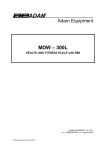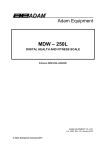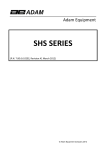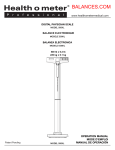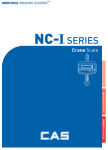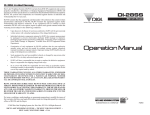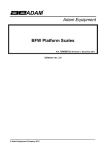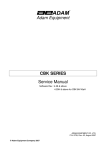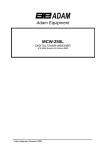Download Adam Equipment MCW Service manual
Transcript
Adam Equipment MDW MCW Service Manual Part No- 700660171 – rev C1 January 2012 Adam Equipment Company Ltd 2012 Adam Equipment Company Ltd 2012 CONTENTS 1.0 PRODUCT DESCRIPTION .................................................. 2 2.0 SPECIFICATION TABLE ..................................................... 3 3.0 TROUBLE SHOOTING GUIDE ............................................ 4 4.0 ERROR MESSAGES FOR MDW MCW .............................. 4 5.0 LOAD CELL REMOVAL AND REPLACEMENT ................... 6 6.0 LOAD CELL WIRE TO INDICATOR CONNECTIONS.......... 8 7.0 CALIBRATION FOR L MODELS........................................ 11 8.0 PARAMETERS .................................................................. 13 9.0 WARRANTY INFORMATION............................................. 20 1 Adam Equipment Company Ltd 2012 1.0 PRODUCT DESCRIPTION The MDW series of health and fitness scales are available in 3 different models. The MDW 160M offering height and weight measurements up to 2.1 metres and 160kg, this is a mechanical scale using a lever work system in the base and a balancing beam type indication. The MDW 250L offering height and weight measurement up to 2.1 metres and 250kg x 0.1kg. The MDW 300L offering height and weight measurement up to 2.1 metres and 300kg x 0.05kg, as well as calculating your BMI following height entry into the Indicator. The MCW 300L is the wheelchair version and has the same functions and specifications as the MDW 300L. A single load cell is used for all 3 L models mounted to the weighing platform and connected to a digital Indicator through a pillar via a cable The digital Indicator used for both capacity models is very similar, the main difference being that the 300kg capacity models use a different software version and have rs 232 as standard. All L type models have as standard a lead acid rechargeable battery fitted internally to the Indicator. 2 Adam Equipment Company Ltd 2012 2.0 SPECIFICATION TABLE MODEL MDW MDW MDW MCW 160M 250L 300L 300L CAPACITY AND DIVISION 160kg x 0.1kg 250kg x 0.1kg 300kg x 0.05kg 300kg x 0.05kg 3 BASE SIZE mm 275 x 375 275 x 375 275 x 375 450 x 450 Adam Equipment Company Ltd 2012 3.0 TROUBLE SHOOTING GUIDE PROBLEM Poor weighing Performance POSSIBLE CAUSES Check for interference with the weighing platform Check that the load cell is fully tightened or the lever works are connected correctly Check that the adjustable weights on the beam are in the correct position Check that the load cell cable is securely connected and not damaged Check that the overload stop is not incorrectly adjusted or loose Check that the product has good stability Incorrect height measuring Height measuring device is loose Height measuring device being operated incorrectly 4.0 ERROR MESSAGES FOR MDW MCW ERROR MESSAGE _____ 0 0_ _ _ _ _ _ _____ DESCRIPTION POSSIBLE CAUSES Zero point exceeds range Zero point is under range EEP.Er CAL.Er A/d exceeds the maximum range A/d is below the minimum range EEPROM error Error when in calibration mode Lo.bat Internal battery voltage too low FULL The weight on the platform exceeds the capacity of the scale Ad Ad_ _ _ _ _ 4 Load cell damage, main PCB fault, Weight left on weighing platform Load cell damage, main PCB fault, Load cell connection problem Improper calibration of the indicator, Load cell damage, main PCB fault Improper calibration of the indicator, Load cell damage, main PCB fault Processor failure Incorrect operation of calibration, Incorrect weight applied for calibration, Weight unstable in calibration mode Battery requires recharging or is faulty, Power adaptor is faulty, main PCB fault Person is too heavy, Error in calibration Adam Equipment Company Ltd 2012 To evaluate that the load cell signal output is correct you can make certain measurements. The load cell functions using a 5Vdc input and this can be checked by placing two individual probes from a multi meter between the (exc +) and (exc-) cables where the load cell cable attaches to the Main PCB or load cell connector. If 5Vdc is present then power is being provided correctly to the load cell, the next step is to measure the output of the load cell, this can be done by placing the 2 probes between the (sig +) and (sig -) wires. In order to obtain an accurate reading the (sig +) and (sig -) wires must be detached (de-soldered) from the connector. You should expect to see a positive voltage reading of between 0 and 2 milli volts when the load cell assembly is at no load, and when a downward force is applied to the load cell assembly the reading should increase. If with no load a reading of more than 2 milli volts is recorded then this suggests damage to the load cell may have occurred and a replacement load cell is required. 5 Adam Equipment Company Ltd 2012 5.0 LOAD CELL REMOVAL AND REPLACEMENT When replacing a load cell the correct type and capacity load cell should be selected, once fitted it will need to be calibrated and checked, there is an overload stop that should be adjusted to protect the load cell. The overload stop should be adjusted to allow the minimum downward movement of the load cell once full load is on the weighing platform, set the overload stop by placing full load evenly onto the platform then adjust the stop screw before locking it into position using the nut provided. To replace a load cell on an MCW firstly unscrew the 4 x fixing screws that secure the foot rest to the chair assembly and remove, then unscrew the 4 x fixing screws that secure the chair assembly to the main frame. This then exposes the weighing platform for both the MCW L and MDW L. Unscrew the 4 x load cell fixing bolts that secure the load cell to the weighing platform and remove. Turn the platform over and unscrew the 4 x load cell fixing bolts that secure the load cell to the main base. The load cell can then be removed and disconnected from the cable connector. Fit the new load cell to the main base ensuring that the arrow for direction of movement points downwards and the 4 x fixing bolts are tightened well, then solder the wires to the Indicator connector. Refit the weighing platform and tighten the 4 x fixing bolts, check that the overload stop is correctly set before testing. Follow the steps below to remove and replace a load cell. 6 Adam Equipment Company Ltd 2012 MCW MCW and MDW L 7 Adam Equipment Company Ltd 2012 Calibration of the new load cell will be required and a check for Repeatability, Off centre loading and Linearity should be made. Main PCB faults are very rare, if you have a problem where power to the PCB is correct and the load cell has been checked and confirmed as fully functional then replacement of the Main PCB is the most effective method of repair. If this is the case, the PCB number and model of machine should be made clear so that the PCB can be programmed and checked first, once checked the PCB can then sent to be fitted directly to the Indicator. Calibration can then be performed and the unit should function correctly 6.0 LOAD CELL WIRE TO INDICATOR CONNECTIONS All load cell to Indicator cables are 4 core and wired via a connector following the pin numbers as below. Pin 1 Excitation plus+ Red Pin 2 Excitation minus – Black Pin 3 Signal minus – Green Pin 4 Signal Plus + White 8 Adam Equipment Company Ltd 2012 The MDW 160M relies on a lever system in the base using bearings and knife edges to transfer the force applied to the weighing platform to a central column. Connected to the top of this column is a beam with a pivoting knife edge, sliding the poise weights along this beam to a graduated weight marking balances the beam when a weight is applied to the weighing platform, the marking is then observed to indicate your weight reading. To calibrate the poise weights you require a load to be added to the weighing platform equal to the maximum marked position on the beam for that poise weight, move the poise weight to the marked position and the beam should balance, if you do not find an accurate balance then add or remove mass from the poise weight. Each poise weight should be adjusted individually using its own beam. The zero poise weight should only be adjusted so that a zero point can easily be achieved with the zero screw, this poise weight has no direct effect on the calibration of the MDW. The knife edges in the base need to be located into the shackles that contains the bearings, if positioned correctly the top pan should always swing freely when moved, if there is any sign of a stiff or uneasy movement then this could point to the base lever works being out of position. To observe the lever works correctly you need to have access from the underside, you will see 4 x platform retaining stops, these are square metal plates held on by a screw that need to be removed for the weighing platform to be detached, once detached you can view the lever works from above. At this point you can observe all of the connecting knife edges and bearings to ensure they are in position, the lever work system should swing and move easily when correct 9 Adam Equipment Company Ltd 2012 10 Adam Equipment Company Ltd 2012 7.0 CALIBRATION FOR L MODELS Before calibrating the scale, you should ensure that you have a suitable known qualified weight for calibration. 1. When in normal weighing mode with the scale at zero press and hold down the [TARE] and [ON / OFF] keys to enter the calibration mode. 2. If the calibration switch is in the off position on the main PCB inside the scale, the indicator will show “CAL OFF” and then exit this mode, if so remove the rear cover of the Indicator and place the jumper in the “ON” position. If the indicator shows “CAL-?”, the scale is ready for calibration. 3. When the indicator shows “CAL-?”, press the [TARE] key to confirm and go to next step. 4. When ‘0.0’ is displayed the scale will begin to calibrate the scale’s zeropoint. Ensure that there is no load or weight on the scale’s platform. Press the [TARE] key to confirm. 5. A few seconds after the [TARE] key has been pressed in step 4 the scale will show “300.0” and the kg LED will be illuminated, or “600.0” and the lb LED will be illuminated depending on which unit you have chosen, this is the default calibration weight from the factory. Press the [UNIT] key to select the calibration weight unit that you want to calibrate in. Press the [Print/Hold] key to choose a different calibration weight value (50kg, 100kg, 150kg, 200kg, 250kg, 300kg or 100lb, 200lb, 300lb, 400lb, 500lb, 600lb); Then put on the weight that you selected and press the [TARE] key to confirm the chosen standard weight that was selected. The displayed data will flash on the display and if the scale accepts the calibration data it will calculate and store the information into the EEPROM. If an error has occurred, the scale will display “CAL. Er” and return back to step 4 for re-calibration. If the loaded weight is not within the range of 95% to 105% of the weight value you selected the scale will not calibrate but display “CAL. Er” and return back to step 4 for recalibration. ) 6. If zero cannot be calibrated at step 4 the ADC needs to be checked and possibly adjusted. Press and hold the [ON/OFF] and [PRINT/HOLD] keys for three seconds after powering up. The display should show “code” then the raw ADC counts. The potentiometer VR1 can be adjusted until the counts with no load are between 20,000 and 30,000. For a working unit the ADC counts should increment approx 35,000 for a 50kg calibration mass loaded. VR1 is situated on the main PCB, please see below diagram. 11 Adam Equipment Company Ltd 2012 7. Check the calibration by putting the weight that you calibrated at back on the scale, if it is not correct repeat the calibration process again. A FACTORY Calibration can be performed if you have problems with the USER calibration, to carry out a FACTORY Calibration press and hold down simultaneously the [UNIT] and [TARE] buttons for 3 seconds whilst the reading is at ZERO, from this point on follow the procedure above from point 2. 12 Adam Equipment Company Ltd 2012 8.0 PARAMETERS This indicator has 4 parameter settings that can be selected. 1. When the scale is in normal weighing mode, press and hold down the [ON / OFF] key and the [UNIT] key for 3 seconds until ‘Setup’ is shown on the display. 2. When in the ‘Setup’ mode, press the [Print/Hold] key to change the flashing digits, and [TARE] key to confirm the flashing digits and move to the next parameter setting. Press the [ON / OFF] key to exit the set up mode. 3. Parameters setting summary: Parameter Available Factory Settings Setting A.o.t. 00-15 05 P.H. 0,1,2 1 H.t 0-4 0 S.F. 0-3 0 Setting Auto-off time: No auto-off = 00. 01-15 minutes auto-off time. Print and Hold Button function 0 = Only Print Function 1 = Only Hold Function 2 = both HOLD and PRINT function To PRINT, push button once To HOLD, push button down for 3 seconds Hold time: 0 = no time limit. 1 = 10 seconds 2 = 30 seconds 3 = 60 seconds 4 = 120 seconds RS 232 Control 0 = No RS232 Function. 1 = Continuously outputs display data. 2 = Outputs display data when PRINT is pressed 3 = Bi-directional communication (the scale receives and executes commands from the HOST device) 13 Adam Equipment Company Ltd 2012 9.0 PARTS LISTS MDW 160M Part number Description Item No 7.00.1.0.0184 7.00.1.0.0134 7.00.1.0.0135 7.00.1.0.0136 WEIGHING RULER ZERO BALANCE WEIGHT 1 2 3 4 7.00.1.0.0132 KNIFE EDGE BEARING FOR BOTTOM OF CONNECTING ROD 5 7.00.1.4.0005 7.00.1.2.0001 7.00.1.0.0130 7.00.1.2.0002 7.00.2.3.0004 7.00.1.2.0003 7.00.1.0.0137 7.00.2.0.0047 7.00.1.0.0129 7.00.1.0.0142 7.00.2.0.0046 7.00.1.0.0133 7.00.1.0.0139 7.00.1.0.0141 7.00.1.0.0140 7.00.1.0.0138 7.00.1.0.0128 7.00.3.0.0011 SMALL POISE WEIGHT LARGE POISE WEIGHT CONNECTING ROD HOOK PIVOT CONNECTING ROD LEVER BRACKET PLASTIC COVER EYE LOOP PILLAR HEAD(T SHAPE) HEIGHT ROD BASE TO INDICATOR CONNECTING ROD PILLAR PLASTIC PLATFORM COVER METAL PLATFORM CENTRE LINK LONG LEVER SHORT LEVER CORNER LINK BASE FRAME 6 7 8 9 10 11 12 13 14 15 16 17 18 19 20 21 22 COMPLETE PACKAGING SET 14 Adam Equipment Company Ltd 2012 15 Adam Equipment Company Ltd 2012 MDW 250L Part number Description Item No 7.00.1.0.0143 7.00.1.0.0144 7.00.1.0.0145 7.00.2.0.0049 7.00.1.0.0146 3.02.4.0.5088 7.00.5.6.0015 7.00.4.0.0037 7.00.1.0.0147 7.00.1.0.0148 7.00.1.2.0004 7.00.4.0.0073 7.00.4.0.0074 7.00.3.0.0012 3.02.4.0.9156 3.02.4.0.9160 3.02.4.0.9159 3.02.4.0.9157 3.02.4.0.9158 7.00.2.0.0048 BASE FRAME 1 2 3 4 5 6 7 8 9 10 11 12 13 HEIGHT ROD HOLDER METAL PLATFORM PLASTIC PLATFORM COVER 210cm HEIGHT ROD 6V dc 4.5ah BATTERY FASCIA MAIN / DISPLAY PCB- STATE WHICH REVISION LOAD CELL LCT LAE-A- 350kg cell PILLAR PILLAR HOLDER ON/OFF SWITCH POWER IN SOCKET COMPLETE PACKAGING SET 12v DC @800ma ADAPTOR-UK 12v DC @800ma ADAPTOR-USA 12v DC @800ma ADAPTOR-OZ 12v DC @800ma ADAPTOR-EURO 12v DC @800ma ADAPTOR-SA INDICATOR ASSEMBLY 16 Adam Equipment Company Ltd 2012 MDW MCW 300L Part number Description Item No 7.00.1.0.0247 MDW 300L HEIGHT ROD SUPPORT (UPPER) 3 7.00.1.0.0248 MDW 300L 210cm SQUARE HEIGHT ROD 4 7.00.2.0.0078 MDW 300L WHEEL ASSEMBLY 5 7.00.1.0.0258 MDW 300L HEIGHT ROD BRACKET (LOWER) 6 7.00.1.0.0145 MDW 300L METAL PLATFORM 9 7.00.2.0.0049 7.00.1.0.0249 MDW 300L PLASTIC PLATFORM COVER 10 MDW 300L PILLAR 11 7.00.2.0.0077 MDW 300L FASCIA 13 7.00.3.0.0020 MDW 300L COMPLETE PACKAGING SET 7.00.0.0.0133 MDW 300L INDICATOR ASSEMBLY 7.00.0.0.0126 MCW 300L CHAIR 14 7.00.2.0.0074 MCW 300L ARM REST (PLASTIC PART ONLY x 2) 15 7.00.2.0.0075 MCW 300L FASCIA 16 7.00.0.0.0127 MCW 300L INDICATOR ASSEMBLY 17 7.00.1.0.0245 MCW 300L PILLAR 18 7.00.1.0.0259 MCW 300L HANDLE 19 7.00.1.0.0243 MCW 300L METAL WEIGHING PLATE 20 7.00.2.0.0076 MCW 300L WHEEL WITH BRAKE (REAR) 21 7.00.1.0.0260 MCW 300L WHEEL SWIVEL (FRONT) 22 7.00.2.0.0073 MCW 300L FOOT REST FRAME ASSEMBLY 23 7.00.1.0.0261 MCW 300L WHEEL FRAME (EXC WHEELS) 24 7.00.1.0.0241 MCW 300L CHAIR FRAME ASSEMBLY 25 7.00.1.0.0262 MCW 300L ARM REST (METAL PART x 2) 26 7.00.3.0.0019 MCW 300L COMPLETE PACKAGING SET 7.00.4.0.0066 MDW MCW 300L MAIN / DISPLAY PCB- WITH RS 232 1 3.02.4.0.5088 MDW MCW 300L BATTERY 2 7.00.1.0.0246 MDW MCW 300L BASE FRAME 7 7.00.1.0.0244 MDW MCW 300L LOAD CELL 300kg cell 8 7.00.4.0.0064 MDW MCW 300L ON/OFF SWITCH 7.00.4.0.0065 MDW MCW 300L LOAD CELL CONNECTOR (2 PARTS) 3.02.4.0.9156 12v DC @800ma ADAPTOR-UK 3.02.4.0.9160 12v DC @800ma ADAPTOR-USA 3.02.4.0.9159 12v DC @800ma ADAPTOR-OZ 3.02.4.0.9157 12v DC @800ma ADAPTOR-EURO 3.02.4.0.9158 12v DC @800ma ADAPTOR-SA 17 12 Adam Equipment Company Ltd 2012 18 Adam Equipment Company Ltd 2012 19 Adam Equipment Company Ltd 2012 10.0 WARRANTY INFORMATION Adam Equipment offers Limited Warranty (Parts and Labour) for the components failed due to defects in materials or workmanship. Warranty starts from the date of delivery. During the warranty period, should any repairs be necessary, the purchaser must inform its supplier or Adam Equipment Company. The company or its authorised Technician reserves the right to repair or replace the components at any of its workshops depending on the severity of the problems. However, any freight involved in sending the faulty units or parts to the service centre should be borne by the purchaser. The warranty will cease to operate if the equipment is not returned in the original packaging and with correct documentation for a claim to be processed. All claims are at the sole discretion of Adam Equipment. This warranty does not cover equipment where defects or poor performance is due to misuse, accidental damage, exposure to radioactive or corrosive materials, negligence, faulty installation, unauthorised modifications or attempted repair or failure to observe the requirements and recommendations as given in this User Manual. Additionally rechargeable batteries (where supplied) are not covered under warranty. Repairs carried out under the warranty does not extend the warranty period. Components removed during the warranty repairs become the company property. The statutory right of the purchaser is not affected by this warranty. The terms of this warranty is governed by the UK law. For complete details on Warranty Information, see the terms and conditions of sale available on our web-site. 20 Adam Equipment Company Ltd 2012 Manufacturer’s Declaration of Conformity This product has been manufactured in accordance with the harmonised European standards, following the provisions of the below stated directives: Electro Magnetic Compatibility Directive 2004/108/EC Low Voltage Directive 2006/95/EC Adam Equipment Co. Ltd. Bond Avenue, Denbigh East Milton Keynes, MK1 1SW United Kingdom FCC COMPLIANCE This equipment has been tested and found to comply with the limits for a Class A digital device, pursuant to Part 15 of the FCC Rules. These limits are designed to provide reasonable protection against harmful interference when the equipment is operated in a commercial environment. The equipment generates, uses, and can radiate radio frequency energy and, if not installed and used in accordance with the instruction manual, may cause harmful interference to radio communications. Operation of this equipment in a residential area is likely to cause harmful interference in which case the user will be required to correct the interference at his own expense. Shielded interconnect cables must be employed with this equipment to insure compliance with the pertinent RF emission limits governing this device. Changes or modifications not expressly approved by Adam Equipment could void the user's authority to operate the equipment. WEEE COMPLIANCE Any Electrical or Electronic Equipment (EEE) component or assembly of parts intended to be incorporated into EEE devices as defined by European Directive 2002/95/EEC must be recycled or disposed using techniques that do not introduce hazardous substances harmful to our health or the environment as listed in Directive 2002/95/EC or amending legislation. Battery disposal in Landfill Sites is more regulated since July 2002 by regulation 9 of the Landfill (England and Wales) Regulations 2002 and Hazardous Waste Regulations 2005. Battery recycling has become topical and the Waste Electrical and Electronic Equipment (WEEE) Regulations are set to impose targets for recycling. Adam Equipment Company Ltd 2012 ADAM EQUIPMENT is an ISO 9001:2008 certified global company with more than 35 years experience in the production and sale of electronic weighing equipment. Adam products are predominantly designed for the Laboratory, Educational, Health and Fitness, retail and Industrial Segments. The product range can be described as follows: -Analytical and Precision Balances -Compact and Portable Balances -High Capacity Balances -Moisture analysers / balances -Mechanical Scales -Counting Scales -Digital Weighing/Check-weighing Scales -High performance Platform Scales -Crane scales -Health and Fitness Scales -Retail Scales for Price computing For a complete listing of all Adam products visit our website at www.adamequipment.com © Copyright by Adam Equipment Co. Ltd. All rights reserved. No part of this publication may be reprinted or translated in any form or by any means without the prior permission of Adam Equipment. Adam Equipment reserves the right to make changes to the technology, features, specifications and design of the equipment without notice. All information contained within this publication is to the best of our knowledge timely, complete and accurate when issued. However, we are not responsible for misinterpretations which may result from the reading of this material. The latest version of this publication can be found on our Website. www.adamequipment.com Adam Equipment Company Ltd 2012
























